
Viz Trio User Guide
Version 4.1 | Published September 25, 2023 ©
Output
To view the Output configuration settings, click Output in the Trio Configuration.
Output Configuration Settings
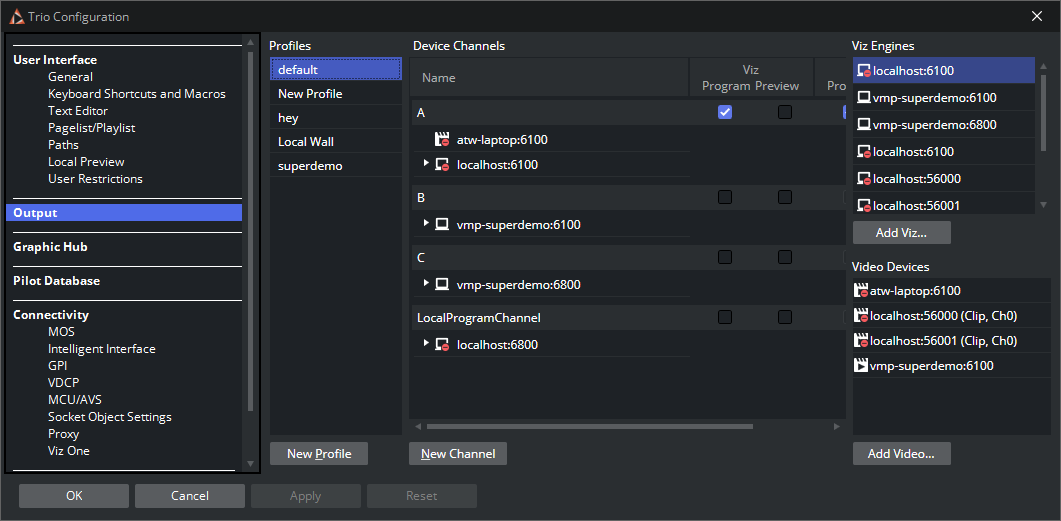
A key feature is the ability to create profiles for different purposes. For example, Profile Setups can be created where different channels have the program and preview function. This makes it fast and easy to switch between different output settings.
Profiles can be defined with different program and preview channels in the Output channels section. It is most common to define a studio with channels mapped to renderer machines (Viz Engine hosts).
Viz Trio supports four methods to resolve which channel is the local program channel. If an unsupported method is used, the Connection Status button will not appear in the Status Bar. Consequently, the operator will not be able to control the local program channel status.
Resolving the Local Program Channel Name
|
Method |
Comment |
|
localhost |
For the program channel; remember to add the port 6800. |
|
127.*.*.* |
Not only 127.0.0.1 refers to localhost. |
|
Hostname |
Name of computer without domain. |
|
IP |
The computer’s IP. If the computer has multiple IPs (e.g. it has multiple network cards), it may still fail. |
IMPORTANT! Although the computer may have several names (for example in /etc/hosts), only the NetBIOS name can be used (the name obtained when running the "hostname" command). It is not possible to add the domain (for example <hostname>.domain.internal).
This section covers the following topics:
Program and Preview Channels
Local preview is Viz Trio’s embedded render window in the lower right corner, which always shows the last page read. Local preview displays graphics as WYSIWYG (what you see is what you get) when editing a page. Text and images change immediately as text and images are added to the page. Select which elements to edit using point and click directly in the render window.
External preview (optional) is a separate Viz Engine renderer with its own reference monitor that displays a true preview. External preview shows how the program channel will look before a page is taken to air.
Program is a separate Viz Engine renderer that renders the content that is taken on-air.
Profile Setups
Profile Setups
|
Profile |
Program |
Preview |
|
Main |
A (Viz 1) |
B (Viz 2) |
|
Backup |
B (Viz 2) |
Two-channel Setup
A typical profile setup is a two-channel setup, program and preview, with one render engine assigned to each channel. A more advanced setup is the use of forked execution. As the term suggests, forked execution is a way to configure a single output channel to contain multiple render engines.
Profiles are used to create different setups, for example in a backup configuration where a switch from a main renderer to a backup is needed. If two output renderers are named A and B, where A is program and B is preview, a profile named "Main" will then have channel A=program and channel B=preview.
If the renderer that is acting as program (A) in the "Main" profile fails, a profile named "Backup" could have channel B=Program.
GPI
Control playout through a General Purpose Input (GPI), for instance through hardware such as a vision mixer.
When GPI is enabled, the external cursor (the GPI system’s cursor) will be displayed in any client that is using the same profile as the external system. A typical setup would be that one Viz Trio client is in the same profile as the GPI system, and functions as a "prepare station" for the producer at the vision mixer desk. Data elements are then made ready and displayed on a preview visible to the producer, and the elements are then triggered from the vision mixer.
Note: This configuration requires a separate "GPI" profile that is not used by other control application clients. Other clients can be in other profiles and produce content to the same output channels. However, they need to be on other transition layers or on another Viz layer so that they will not interfere with the graphics controlled by the external system.
A channel can be designated as a Program or Preview channel by selecting the appropriate check box. The program and preview channels are reciprocally exclusive - only one channel can be set to program, and only one channel can be set to preview. For example, if A is set as program and B is set to preview and C is set to program, A will no longer be set as program.
When configured to use video in graphics from a video server (for example Viz One), it is currently recommended to use IP addresses for both the Viz and Video channels in order to visualize the transfer progress correctly; hence, a hostname on the Viz channel will work, but not on the Video channel. They must also match the video configuration for both program and preview.
The Video device configuration is used when configured to trigger video elements in a video server setup.
IMPORTANT! Current limitations require that both graphics and video channels use an IP address.
Forked Execution
Forked execution can be used with standalone and transition logic scenes, and replaces the execution of visible containers.
This section covers the following topics:
Standalone Scenes
Forked execution supports standalone scenes by executing the same graphics with different concepts on two or more render engines. Concepts are defined per channel when Working With the Profile Configuration tool.
As an option you can also use this setup to handle fail situations by having the same graphics concept rendered on both engines.
Transition Logic Scenes
As with Standalone scenes, forked execution supports setting concepts for Transition Logic scenes. In addition Transition Logic scenes, by defining channels with different render engine setups, can show different states of the same scene on a per engine basis. All states are synchronized for all engines (at all times) in order to achieve an artifact-free and smooth morphing of the graphics from one state to the other.
For example, if you have three render engines you can set up a range of channels with different combinations of render engines per channel.
|
Channel |
Viz Engines |
|
A |
1,2,3 |
|
B |
1,3 |
|
C |
1 |
|
D |
2,3 |
|
E |
2 |
For example, if a scene has four layers, each layer can be controlled separately from the other layers (see table below). By setting a state per layer you can achieve a varied output depending on the channel used and how that channel is configured in terms of render engines (see table above).
-
Layer 1: Shows and hides a geometry (e.g. a cube)
-
Layer 2: Shows and hides some text
-
Layer 3: Positions the geometries
-
Layer 4. Animates the layer 1 geometry by showing the next image or a logo
States for Layer 1
States for Layer 2
States for Layer 3
States for Layer 4
Show cube
Show text
Position left
Next image
Hide cube
Hide text
Position right
Show logo
<ignore>
<ignore>
Position center
<ignore>
<ignore>
With the scene layers and configured channels above you can have the following output on each of the three engines:
|
Channel |
Layer State |
Output on Viz Engine 1, 2 and 3 |
|
Channel C(Viz 1) |
Show cubePos leftShow textShow logo |
|
|
Channel D(Viz 2,3) |
Show cubePos rightShow TextShow Logo |
|
|
Channel E(Viz 2) |
Pos centerHide text |
|
|
Channel A(Viz 1,2,3) |
Next image |
|
|
Channel A(Viz 1,2,3) |
Next image |
|
|
Channel A(Viz 1,2,3) |
Show textNext image |
|
|
Channel A(Viz 1,2,3) |
Show logo |
|
|
Channel B(Viz 1,3) |
Hide cube |
|
|
Channel E(Viz 2) |
Hide cube |
|
Visible Containers
Although it is considered deprecated, a behavior similar to that of forked execution is supported. By designing a standalone scene where each root container is a variant of the other, you can configure each render engine to render specific containers (by name). In effect, a scene with two or more root containers can have one or more containers assigned and rendered visible by a single render engine.
Note: Due to potential performance issues when using large textures (e.g. HD), this option is no longer recommended. Concept and variant design of standalone and transition logic scenes is therefore the recommended design convention.
Working with the Profile Configuration
This section covers the following topics
-
Profile Configuration:
-
Channel Configuration:
-
Output Device Configuration:
Profile Configuration
To Open the Profile Configuration
-
Click the Config button (upper left), and then select Output.
-
Right-click the profile on the status bar (lower-left) and select Profile Configuration... from the menu.
To Add a New Profile
-
In the Profile Configuration window, click New profile, enter a new unique profile name in the text field and press Enter.
To Rename a Profile
-
Right-click the profile and select Edit Profile Name or simply double-click the profile and enter a new name.
-
When finished editing the name, press Enter or click outside the Profiles list.
To Delete a Profile
-
Right-click the profile and select Delete Profile, or simply select it and press the Delete button.
Channel Configuration
To Add an Output Channel to the Channels List

-
Click New channel or drag and drop a Viz Engine or video device to the Channels list.
To Rename an Output Channel in the Channels List
-
Right-click the channel and select Edit Channel Name from the menu or double-click the name.
To Remove an Output Channel from the Channels List

-
Right-click the channel entry and select Delete channel from the menu or select the channel and press the Delete button.
To Add an Output Device to the Channels List
-
Simply drag and drop a Viz Engine or video device onto the channel in the Channels list, or select it and select Add to profile (for creating a new channel) or Add to selected channel from the menu.
To Remove an Output Device from the Channels List
-
Right-click the Viz Engine or video device and select Delete Output from the menu or simply select it and press Delete.
To Add a Concept Override for a Channel Output Device
It is possible to override the concept on Viz Engine output level. This concept override will take precedence over concepts set in the show or on the playout elements.
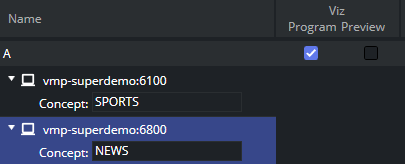
-
Expand the channels output device and append the concept name. This will override any concepts set elsewhere.
-
Click OK.
Caution: Note that concept names are case sensitive.
Output Device Configuration
Adding a Viz Engine
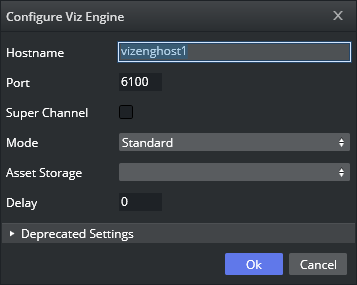
-
Click Add Viz... in the Profile Setups window to open the Configure Viz Engine dialog box.
-
Enter the Hostname.
-
Default port for Viz Engine is 6100 or 56000 for Super Channels.
-
Optional: Select Mode.
-
Select whether the video device is a regular or controlled through a Viz Artist Super Channel plugin.
-
Set a delay (optional).
-
Optional: Select an Asset Storage location. Asset Storage lists available Viz Engine clip transfer and playout destinations.
-
Click OK. A status indicator will show if the renderer is on-air.
Adding a Video Device
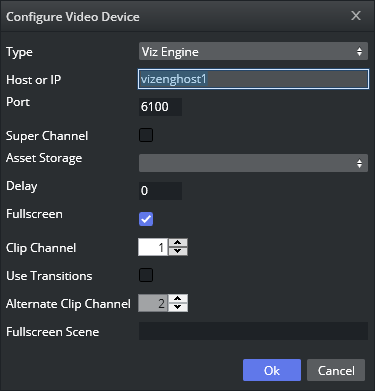
-
Click the Add Video... button in the Profile Setups window to open the Configure Video Device dialog box.
-
Select the video server Type.
-
Type the Host or IP address.
-
Enter the Port number (optional).
-
Select whether the video device is a regular or controlled through a Viz Artist Super Channel plugin.
-
Set a delay (optional).
-
Select a publishing point from the Asset Storage list, so that stand-alone clips and clips used in pages or data elements are transferred to the right location (the specified Viz Engine) for playout.
-
If the Fullscreen check box is selected, you can define additional values (Use Transitions and Fullscreen Scene) in order to provide transition effects from one video to another.
Note: The fullscreen values are only available for Viz Engines, not MVCP video devices.
IMPORTANT! Trio by default sets the Fullscreen Scene in Media Sequencer to Vizrt/System/transitions when you switch on Use Transitions. Using this default, clip channel must be 1 and the alternate clip channel must be 2. Only when using other transition scenes can these settings be changed.
-
Select the Clip Channel to use.
Note: Viz Engine from 3.6 support up to 16 clip channels which can be used for playout. A clip channel might be unavailable for various reasons: for example, if it's configured to be inactive in Viz Config or if the license only covers a limited number of clip channels.
-
Alternate Clip Channel: When using videoclip transitions the clip from Clip Channel will transition to the clip from Alternate Clip Channel and the next clip will transition from Alternate Clip Channel back to the Clip Channel. The transition clip channel is only enabled in the configuration window if Use Transitions is enabled.
-
Click OK. A status indicator shows if the video device is online.
IMPORTANT! Media Sequencer up to and including version 2.0.0 imposes the following limitations: Clip channels 3-16 are not supported when using fullscreen clips. Clip channels 2-16 are not supported when using transitions. Using the alternate clip channel setting is not supported. These restrictions are lifted starting with Media Sequencer version 2.0.1 and higher.
Tip: You can use the default profile to transfer video from Vizrt’s MAM systems (unless you have manually configured a profile in both systems).
Editing a Viz Engine or Video Device
-
Right-click the device and select Edit from the menu or simply double-click the device.
Deleting a Viz Engine or Video Device
-
Right-click the device and select Delete from the menu or simply select it and press the Delete button.
Enabling Scene Transitions
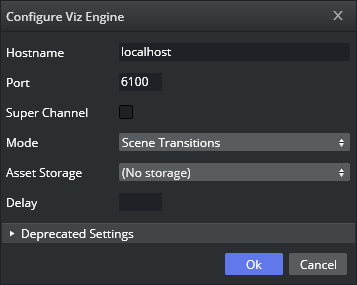
-
Configure the Viz Engine settings as seen in how To add a Viz Engine.
-
Set the Mode to Scene Transitions.
-
Scene Transitions: Allows the renderer to copy (or snapshot) the scenes to create a transition effect between them.
-
-
Open the Show Properties, and set the Transition Path. See also Transition Effects.
-
Click OK.
-
Add the program renderer to the program channel.
Note: The program channel must be configured and on-air in order for the effects to be visible.
Enabling Still Preview
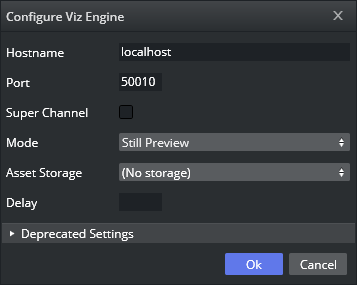
-
Create two channels, one for program and one for preview.
-
Configure the same render engine twice as seen in how To add a Viz Engine.
-
For the second render engine set the Mode to Still Preview.
-
Still Preview: Allows you to use the program output to get a still preview. To achieve this the Media Sequencer creates a copy of the scene being read and sends commands to your program output renderer asking for a snapshot of the scene while the current scene on air is being rendered. Note that the port used for still preview is 50010.
-
-
Click Ok.
-
Add the program renderer to the program channel and the still preview renderer to the preview channel.
Warning: This setup requires sufficient ring buffer on the program renderer in order to prevent the rendered still preview from causing the scene on air to drop frames. This setting is therefore deprecated.








